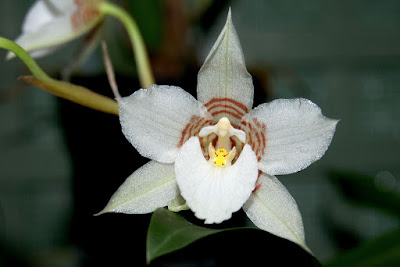Rhynchostele cervantesii is native to Mexico. It is quite a popular species in the states of southern Mexico: Oaxaca, Jalisco, Michoacan, Mexico and Guerero, and its occurrence may extend to the states of Durango and Sinaloa...
Rhynchostele cervantesii also called as Cervantes' Rhynchostele, Amparoa cervantesii, Amparoa cervantesii subsp. membranacea, Amparoa cervantesii subsp. occidentalis, Cymbiglossum cervantesii, Lemboglossum cervantesii, Odontoglossum cervantesii, Odontoglossum cervantesii var membranaceum, Odontoglossum membranaceum, Oncidium cervantesii, Oncidium membranaceum, Rhynchostele cervantesii subsp. halbingeriana, Rhynchostele cervantesii subsp. membranacea, is a species of the genus Rhynchostele. This species was described by Soto Arenas & Salazar in 1993.
IDENTIFY RHYNCHOSTELE CERVANTESII
Rhynchostele cervantesii is native to Mexico. It is quite a popular species in the states of southern Mexico: Oaxaca, Jalisco, Michoacan, Mexico and Guerero, and its occurrence may extend to the states of Durango and Sinaloa. These orchids grow on trees or rocky slopes in moist, relatively shady, mixed pine-oak forests, at an altitude of 1500-3000 m.
It is a cold to cool growing epiphyte, which reaching 8-22 cm in height, with clustered, grey green, ovoid, slightly flattened, four-angled, ancipitous, 2.5-6.5 cm tall pseudobulbs, that are brown or spotted with brown, carrying a single, apical, oblong, acute, 5-16 cm long leaf with a conduplicate petiole.
Cervantes' Rhynchostele blooms with 2 to 6, fragrant flowers on a nodding or pendant, 15 to 20 cm long inflorescence with linear, acuminate, brownish bracts occurring in the winter through the spring. The flowers are 4-6 cm wide and are large in relation to the size of the entire plant. They have a sweet fragrance and are long-lasting, as long as low temperatures and shading are maintained. The petals of both whorls may be white to pink and have concentrically arranged red-brown spots or lines at their bases. The lip has a heart-shaped shape and the same color as the other petals.
RHYNCHOSTELE CERVANTESII CARE AND CULTURE
Cultural information should only be used as a guide, and should be to be adapted to suit you. Your physical location; where you grow your plants, how much time you have to devote to their care, and many other factors, will need to be taken into account. Only then can you decide on the cultural methods that best suit you and your plants.
Light:
Rhynchostele cervantesii needs a light level of 20000-25000 lux.
Temperature:
The average temperature of the summer day is 24-25 ° C, night 12 ° C, which gives a daily difference of 12-13 ° C. The average temperature of the winter day is 22-24 ° C, the night 5-7 ° C, giving a daily difference of 17 ° C.
Humidity:
From summer to early autumn, Cervantes' Rhynchostele needs the average humidity of almost 70%, but it drops to 55-60% in winter and early spring.
Substrate, growing media and repotting:
Rhynchostele cervantesii are usually grown on tree ferns or cork, but then you should ensure high humidity and summer watering at least once a day.
Watering:
In the natural habitat, rainfall is moderate to heavy for 6 months, from late spring to early autumn, but then precipitation drops sharply, going into a 4-6 months dry season, which lasts until the beginning of the next spring. The cultivated plants should be often and abundantly watered during the growing season, but their roots must always dry quickly after watering.
Fertilizer:
Weekly use of 1/4-1/2 dose of fertilizers during active growth is recommended. You can use a balanced fertilizer, or use high nitrogen fertilizer from spring to mid summer, then high phosphoric fertilizer from mid-summer to autumn.
Rest period:
In winter, Rhynchostele cervantesii need less water, but they can never dry up completely. Morning fogging can provides enough water, so that the pseudobulbs do not wrinkle. Watering is best done during sunny weather. Fertilization should be reduced or eliminated until the temperature rises in spring and watering increases. The level of light in winter should be the maximum light level so as not to burn the leaves.















COMMENTS